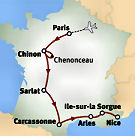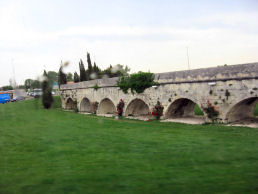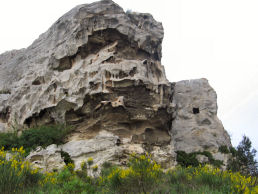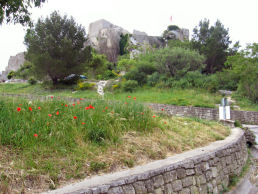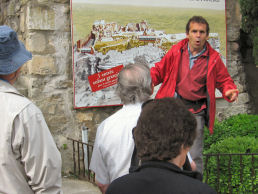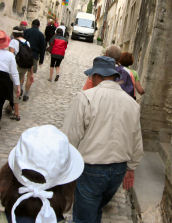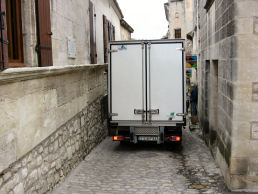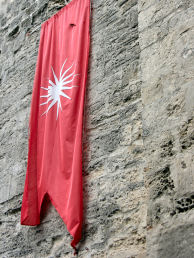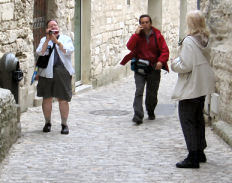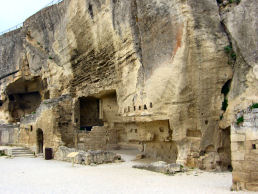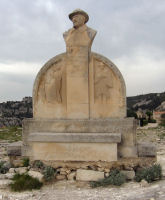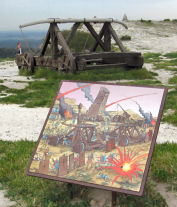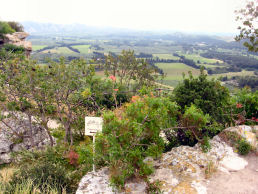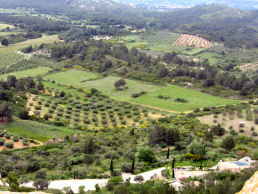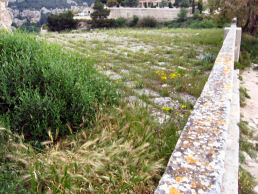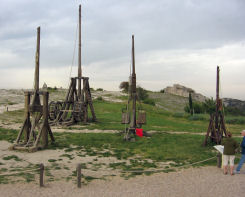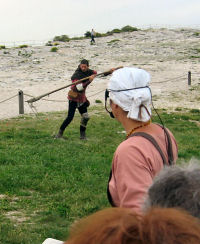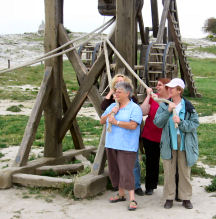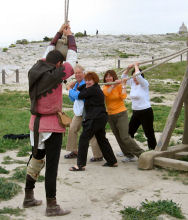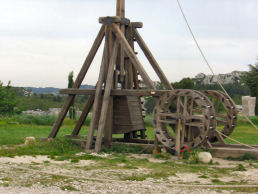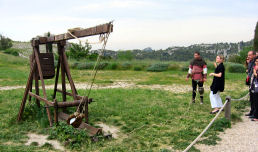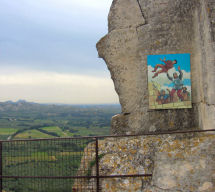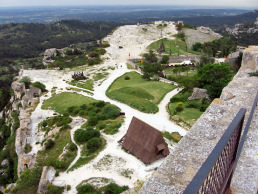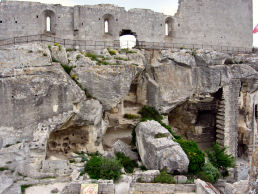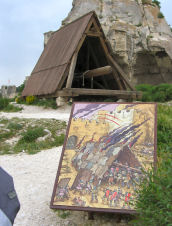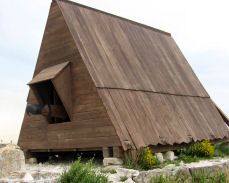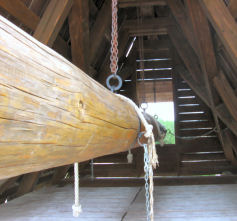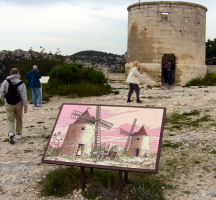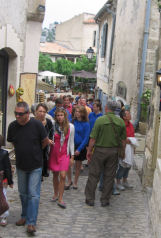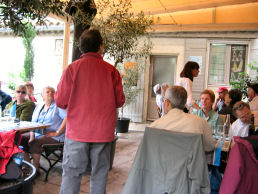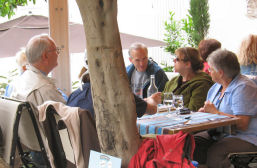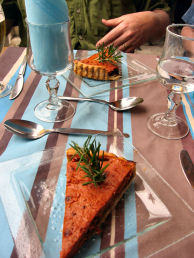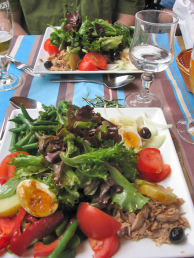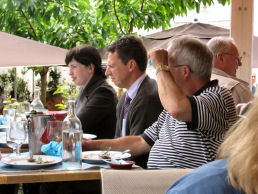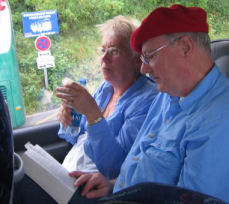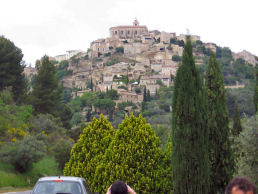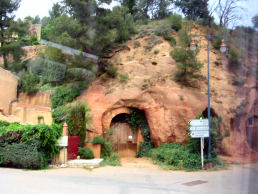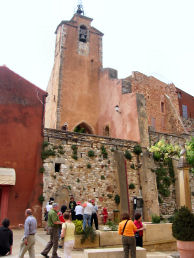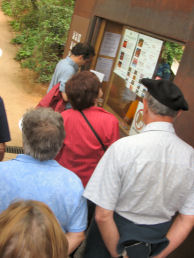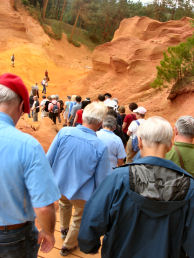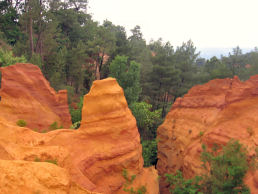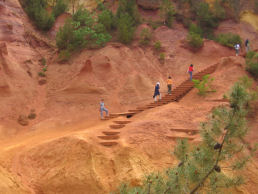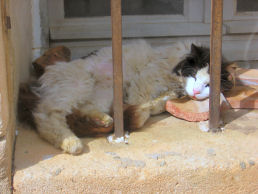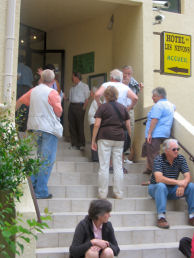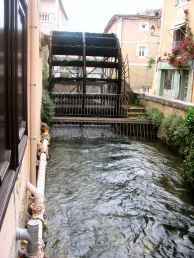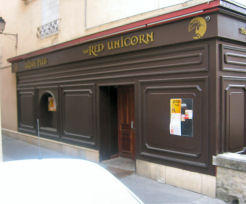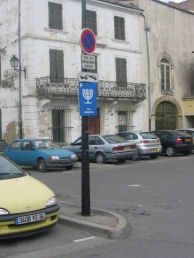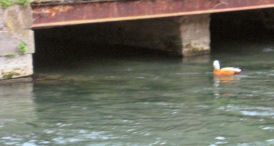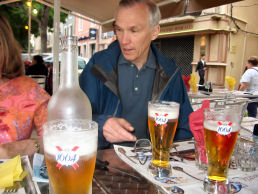
Just as importantly, I have always set a high value on promptness. It pained me to the quick to be holding the whole group up. Five minutes times thirty people is equivalent to two and a half hours. Patrick must have sensed my frustration; he told me not to worry and emphasized that we were still on schedule.
On the bus ride through Provence Patrick mentioned Alphonse Daudet, a local author with whom I was not familiar. One of his famous works was Tales of my Windmill. Spoiler alert: The goat gets it in the end. A stocking cap got passed for Olivier’s tip. One of the McKenzie Brothers must have supplied it. I chose not to contribute. Olivier did an admirable job, but so did the drivers on all of our other tours, and no one suggested that they needed to be tipped. The members of all three previous tours did contribute to a gift for the guide. I wondered if someone would do the same for Patrick, who worked as hard as any guide whom I had encountered. Patrick informed us that the word bauxite came from our next stop, Les Baux. The mineral was discovered in the vicinity in 1822, but it had all long been mined out. The town itself, which was completely devoted to tourism, sat atop a steep hill. The road to the top was full of switchbacks. The château was heavily fortified, to say the least. I would not have liked to try to assault this place. Patrick provided us with a good deal of fascinating information about the town and the family for which it was named. The Les Baux family claimed to be descended from Balthazar, one of the three wise men of Matthew's gospel. Did anyone actually believe this? Maybe so. Their battle cry was “Au hazard Balthazar.” At one time the lords controlled seventy-eight other estates in addition to Les Baux. Quite a bit of time was allotted to us for exploration of the grounds of the château. I really enjoyed the whole experience. The views were spectacular, the audio guides were a good source of interesting information, and the cartoon-like pictures that were provided at each location were helpful and entertaining. Humor (or even whimsy) was seldom found in presentations dealing with any area’s patrimony.The most severe problem that I encountered in Les Baux was not having enough hands. I needed one for the audio guide, one for my notebook, one for my pen, and at least one for my camera.
Among the interesting items on display were several trebuchets, a battering ram, the remains of a windmill, and an area in which large flat stones had been arranged so as to funnel rainwater to the cistern. Patrick had explained to us how the last of these worked. Three large towers with incredibly rickety staircases were available for climbing. Initially Patrick said that it was too early in the season for demonstrations of the trebuchets. However, shortly after he told us that, something must have been arranged behind the scenes; a demonstration was scheduled for eleven o’clock.I managed to scale one of the towers before the demonstration began. Almost at the top was a sign portraying some men-at-arms hurling a young man over the side of the wall. From the top I took quite a few interesting photos of both the interior and the surrounding countryside.
Two costumed employees of the exhibit conducted the trebuchet demonstration. The guy operated the equipment while the lady provided explanations in French. The tour group all gathered around Patrick, who translated what the lady said into English. Other visitors, who evidently understood French, stayed on the outskirts. The first demonstration was the simplest and in some ways the most impressive. The guy showed how to use a sling mounted on a stick. He placed the stone in the sling and then stepped on it. He then stretched the leather tight, held it for a second and then lifted his foot. The rock flew out at quite a rapid rate and went well over forty yards.Eight female volunteers then launched a water balloon using a human-powered catapult called a bricole. The guy held down the sling holding the balloon while the ladies pulled as hard as they could. The balloon only went a few yards, but everyone was surprised that it worked at all. The bricole was a defensive weapon. A stone from one of them felled Simon de Montfort when he was laying siege to Toulouse.
The lady described the couillard[2], an offensive siege weapon that had a long mast and two counterweights. She said that it could fire ten stones per hour. It took quite a few minutes to get the rope wrapped around the spool. In battle at least three to five people would be required to man the machine. Although she talked quite a bit about this machine, the guy actually demonstrated with a smaller one that had a shorter mast and only one counterweight. A female francophone from the audience held the rope. Trebuchets were invented by the Muslims in the twelfth century. They were used up to the sixteenth century. They could launch stones of up to four hundred pounds two hundred to three hundred yards. The missile would travel at about one hundred miles per hour.
I think that Patrick reported that the lady narrating the demonstration said that the first gunpowder cannons were deployed in the fourteenth century. I also heard something about the fifteenth century. You can look it up yourself.
By the time that the demonstration had completed, Les Beaux had grown much more crowded than when we arrived in the morning. Tom Corcoran and I walked back to the towers and climbed one of them. It was easier than the first one. We skipped the middle tower.
Tom wanted to go to the weaponry demonstration. I just wandered back down through the town. I was somewhat surprised to happen upon the three Italian ladies who had arrived shortly after us on the Terrasses of the Popes’ Palace in Avignon the previous day. I did not see any shops that interested me enough to merit closer scrutiny. Patrick doubted that it would be possible to get lost in Les Beaux, but I nearly proved him wrong. I eventually managed to find the Hostellerie de la Reine Jeanne, our restaurant for lunch, but only after several wrong turns.
Patrick had to chase Sue and Lee down to the restaurant. Our group entirely filled the restaurant’s patio. Sue and I sat with the Corcorans at lunch. The starter was an unusual tart that contained eggplant and pepper. It certainly sounded weird, but my taste buds liked it. That was followed by a massive salad Niçoise of greens, hard-boiled eggs, tuna, onions, peppers, and green beans. Dessert was a tart filled with blueberry, currants, and clotted cream with powdered sugar on top. Tom and I ordered Stella Artois on tap for 2€, which for a tourist destination in France was a real bargain. Sue and Patti shared some white wine that cost 5€. This was a really good lunch from start to finish.
Almost as soon as they sat down, Dave and Mary had to move. I later asked them why. Dave said that it was because of the rain. There may have been a few drops, but as soon as Dave and Mary had moved, the rain stopped, and the sun even came out.
On the bus Nancy handed out contact sheets for us to fill out if we were willing to share our e-mail addresses and/or physical addresses with the other members of the tour. I was definitely relieved that someone was taking charge of this task. In the past I always have notified everyone on every tour when I put a new journal on my website. I was afraid that perhaps Patrick did not believe in the traditional exchange of e-mail addresses, and I certainly did not relish the idea of having to collect each fellow traveler’s e-mail address individually.
The bus passed through the village of Saint Rémy-de-Provence. Patrick told us that it was called Glanum by the Romans. It was an upscale little town that had been patronized by the Grimaldi family, the rulers of Monaco. Nostradamus was born there.
The Luberon region of Provence provided the setting for Peter Mayle's best seller, One Year in Provence. Cherry trees were commonly grown in the area. The town of Cavaillon was so proud of its cantaloupes that it had erected a gigantic statue of one near an intersection. I twice missed good opportunities to photograph it.[3] As we drove by, Patrick pointed out some bories, little stone houses once used by laborers. A whole village of them was recently discovered near Gordes in the Luberon. We stopped the bus for five minutes to allow everyone to take photos of the fortified hill town.After Tom Corcoran and I finished walking the “long trail,” there was more than enough time to explore Roussillon. We split up. My only interest was in a bookstore, but there were none to speak of, or at least none that I could find. I did discover a place in the sun to sit and watch the passersby. A group of high school-aged girls on a school outing went by. One of them was feeling faint or something. A few soothing words from her friends seemed to help her get better.
What interested me most was a kid on a plastic bicycle with training wheels. The cool thing was on the back of the bicycle, where a long handle stuck out and up at a forty-five degree angle. The little guy’s father used it to push him along. I did not have my camera at the ready, so I did not get a photo of them. The dominant topic of conversation in the tour group for the last day or so had been the obvious fact that half or more of us had had to deal with the sniffles or worse for at least a day or two. What’s more, it seemed to have gotten worse once we had entered Provence. Patrick had reported on the bus that the Mistral Wind had reportedly made people in Provence go crazy. I naturally approached him and asked him how this happened. Did the Provençals lose their minds through their nasal passages? He did not get it. Oh, well. I was 0 for 2[4] on my jokes. Our ultimate destination was the village of L’Ile-sur-le-Sorgue, which was sort of an island in the Sorgue river. The river, which was only about fifteen feet wide and did not look very deep either, forked around the town. There were also a couple of canals running through the island. The result was that a high percentage of the restaurants allowed views of one waterway or another. Five or six large wheels were turned by the current for no evident purpose except to add atmosphere for the tourists. Our group stayed at the Hotel Les Nevons, which was just a short distance from the island itself. This hotel was much larger than any in which we had stayed since Paris. That came as a surprise, because L’Ile-sur-le-Sorgue was probably more obscure than any other stop on the tour. Sue and I were assigned room #220. Patti and Tom were in #221. I finally figured out that the reason that our room had always been so close to the Corcorans’ was that Patrick assigned them alphabetically, and Sue’s last name immediately preceded theirs. The most peculiar thing about the room was that the toilet was in a separate room from the bath, an arrangement that yielded both advantages and disadvantages. The fact that there was no bidet no longer surprised me. The shower was hand-held and very difficult to manage. French hotels really needed to learn how to do showers. Could it conceivably be that difficult? One nice aspect of the room was that it had a balcony. The Corcorans’ balcony was right next to ours.We were on our own for supper. Patrick brought us to the center of the town and then turned us loose. Tom Corcoran saw a sign for an “Irish Pub.” Six of us – Tom and Patti, Brad and Donna, and Sue and I – set out in search of the pub. We followed the signs, but we could not find it. We had to ask someone for help.
We entered the Red Unicorn and sat at the corner booth. Tom insisted that all Irish Pubs served food, but this one did not have menus or waiters. Furthermore, we could see the whole establishment, and it seemed to lack a kitchen. Well, we could at least get a beer and then go get some food elsewhere. They had Guinness on tap, which is what I was looking for. However Brad announced that he did not want to drink a beer. So, a reasonable question was, “What are we doing here?” We decided to go elsewhere and get some food.
As we were leaving, Tom let the bartender know that he would be back.[5] My impression was that this was really a sports bar. I did not get the impression that the European Union closely monitored which establishments used the term “Irish Pub” and insured that they all served food that could pass muster in Dublin or Kilkenny.We left the pub and strolled past it toward the water. From the other direction “Wheel River Irish Pub” was written on the wall of the building that housed the Red Unicorn. Were there two of them? Did one pub have two names? We never found out.
We decided to stop for pizza at the Pizzeria au Fil de L'Eau. We found a table outdoors near the water. I ordered Pizza Roma, which featured anchovies and capers just like the Pizza Napoli that I had ordered in Carsac. Sue had her favorite, Pizza Quatre Saisons, which had ham, artichokes, and olives. Four seasons pizza customarily features a different topping in each quadrant, but this one only had three toppings, and they were mixed together. We were forced to conclude that the E.U. did not monitor pizza very well either. Patti and Donna both chose Pizza Marguerite, which had cheese and olives. Tom continued his quest for the perfect Chorizo pizza. Maybe he was angling for our next destination to include Portugal. Brad ordered a pizza with tuna. Really. All three men opted for the 1664 beer that was on tap.Donna ordered crème brûlée for dessert. Patti had her usual café au lait. I selected the café noir, which turned out to be a small espresso.
We enjoyed the meal, but the restaurant only had one waitress, and she was a little overwhelmed. She had quite a few tables to deal with, and she had to cross the street to get to the kitchen. Perhaps they staff up during the summer.
The bad part was that our waitress did not speak English at all, and we had a little trouble communicating. She never brought the second carafe of water that we requested. The good part was that she forgot to put my coffee on the bill. The total cost for Sue and me was only 25€.
During supper the women fed the ducks that were swimming in the river. The reddish brown one was Patti's favorite even though it seemed a little stupid. Both Patti and I took numerous pictures of the ducks. From the restaurant I could see a BNP Paribas branch on the other side of the river. I toted up our liquid assets and determined that we would need at least another 150€. After supper we all crossed the bridge together. The rest of the group turned left toward the hotel. I turned right, walked to the ATM, and withdrew some money.On the way back from the bank I encountered a café that was closed. On the street was piled a bunch of what the French might term “junque.” I tried to imagine what its purpose was. Were they trying to imitate a café in Paris? Was this actually one of the many antique dealers in the area about whom Patrick had told us? I documented the scene with pictures from many angles.[6]
I stopped at the hotel’s reception desk and got the Wi-fi code. It seemed to work very well. I signed on to the Internet, but I learned nothing of import. I downloaded my camera and cleared the memory card. I then saved my pictures and my journal to my flash drive.
Sue told me that because we were only spending one night in L’Isle-sur-le-Sorgue, she did not even intend to unpack.
I tried to work on my journal, but I was too sleepy.
I had not been in dreamland long when I was awakened by some giggling. Evidently Sue and Patti had been playing Yahtzee with some weird dice that Patti had acquired somewhere. They both were enjoying great success. The laughter intensified when they realized that they had been playing with six dice, not five. So, in the Conneticut contingent “not playing with a full deck” has been replaced by “playing with six dice.”
[1] Not quite everywhere. I found it on June 11 in a pocket of my backpack that contained the padded laptop holder, which I never used on the trip. Until I removed the holder, I could neither see nor feel the book.
[2] I also wrote down “biffa deux,” but I could find no references to this term on the Internet. My spelling might be wrong.
[3] I could not find an image of it on the web either.
[4] Actually 1 for 3. I forgot about the British woman in line at Versailles.
[5] I later learned that he did in fact return. The beer was bad, and everyone else in the pub was only there to watch a soccer game between two Latin American national teams.
[6] Somehow my supposedly foolproof method of downloading the photos from my camera to the computer lost the last seventeen out of the 318 photos that I took on this day. There were two peculiar aspects to that day’s photos: 1) It was the only day that I took more than three hundred photos. 2) After the file named img_9900 the next image was named img_0001. On the positive side, if I were forced to sacrifice seventeen consecutive photos, I would be hard-pressed to find a group that I treasured less.
